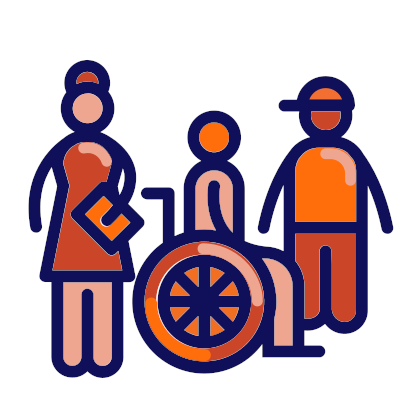Preventing bullying and violence

Schools can, and should, play a key role in tackling these abuses.
Whole-school anti-bullying programmes are needed, which promote peer support systems and involve active and well-trained teachers and parents, to foster a safe learning environment in which no violence is allowed.
Facts & figures
Half of the world’s students aged 13-15 say they have experienced violence in and around school.[1]
Nearly one in three students of this age say they have experienced bullying or been involved in fights.[2]
More than 700 million children have no legal protection from corporal punishment at school.[3]
What is violence and bullying?
Violence is the threatened or actual use of physical force or power resulting in physical or psychological harm to others.
Bullying is a form of violence. It can be defined as unwanted, aggressive behaviour which involves a real or perceived imbalance of power. It is behaviour that is repeated, or carries the threat of being repeated over time.
Bullying takes different forms in school, including:
- Physical, e.g., hitting, kicking, slapping, shoving, hair-pulling, etc.
- Verbal, e.g., name-calling, teasing, using belittling expressions, etc.
- Relational, e.g., ostracising, spreading rumours, social manipulation, etc.
- Sexual, e.g., sexual name-calling, uninvited touching, propositioning, etc.
Cyberbullying is a distinctive form of bullying. It differs from other types on account of the constant risk of public exposure, the complex roles of observers and the size of the audience that comes with digital technologies.[4].
Bullying is not the only form of student-on-student violence in schools, however. Fights between, and attacks on students associated with gang culture and the carrying of weapons, especially knives, are becoming an increasing problem in various countries.
Why is addressing violence and bullying important at school?
Under the U.N. Convention on the Rights of the Child, schools have a formal duty to protect children from all forms of violence, both physical and psychological.
“Parties shall take all appropriate legislative, administrative, social and educational measures to protect the child from all forms of physical or mental violence, injury or abuse, neglect or negligent treatment, maltreatment or exploitation, including sexual abuse, while in the care of parent(s), legal guardian(s) or any other person who has the care of the child.”[5]
Failure to protect children at school can have harmful repercussions on their future lives, both educationally and socially - whether they be victims, perpetrators or bystanders.
Students who are bullied are more likely to suffer from depression and anxiety, health issues, poor academic achievement and behaviour problems at school, including higher drop-out rates. A small number may also retaliate in violent ways. Students who bully others are more likely to exhibit other behaviour problems at school and to suffer from alcohol or drug abuse, and to engage in criminal activity and abusive relationships in adulthood. Children who witness bullying and violence are also more likely to have mental health difficulties and miss or drop out from school.
Violence and bullying not only affects academic learning, it also impacts negatively on the social development of young people. In particular, students who experience violence and bullying are more likely to have difficulty developing basic democratic competences, such as empathy, respect for others, openness to other cultures and beliefs, tolerance of ambiguity and self-efficacy – all of which lie at the heart of the Council of Europe Reference Framework of Competences for Democratic Culture.
The effects of violence and bullying are not limited only to the students directly involved, but potentially impact on everyone at a school. Unchecked, incidents of violence and bullying lead to an atmosphere of anxiety and insecurity incompatible with learning. They also lead to, or exacerbate conflicts beyond the school gates, which in turn have further consequences for relations within the school.
What are the challenges?
Violence and bullying can be challenging to deal with at school. What is regarded as bullying or violence is sometimes thought of as a matter of subjective opinion. It can be difficult to build a common approach to eradicating from school something which a significant proportion of staff believes not to exist or is not important to them.
The prevailing culture in a school can sometimes work against attempts to reduce violence in its different forms. Rule by fear, over-emphasis on punishment and the prioritization of learning environments which support competitive behaviour all militate against the prevention of violence and bullying. So, too, does the holding of an ideology which accepts violence as a valid response in situations of fear, stress or frustration – as evidenced in the advice commonly given to victims of bullying to fight back and give the bully a ‘taste of their own medicine.’
In such circumstances it can be easy to think that dealing with violence and bullying is simply a matter of stopping fights, giving punishments and imposing order, rather than questioning the wider culture of the school, the examples it sets and the sorts of behaviour it supports.
Many teachers are unaware of democratic approaches of dealing with violence and bullying, such as:
- restorative justice
- conflict resolution
- peer mediation.
Such approaches are not only arguably more effective than punitive ones, but also have the advantage of promoting democratic values and attitudes more widely across a school.
Such approaches take time to learn, however, and require the development of specific types of skills, knowledge and attitudes. They also take time to put into practice. It can be difficult for a teacher to find the time and motivation to deal with violence and bullying in a democratic and constructive way. It is easier just to punish the supposed perpetrator, and easier still to pass the perpetrator up the school hierarchy for a more senior member of staff to punish.
A further challenge in recent years has been the rise of gang culture among young people and the carrying of weapons, especially knives, in as well as out of school. This has led to a rise in the number of serious acts of violence between students and also to the more regular involvement of the police in school affairs, both of which demand new professional skills and ways of working from teachers and school leaders.
How can schools get active?
Taking action on violence and bullying is not just a matter of finding better ways of responding to incidents after they have occurred – though this is important, but also of creating the kind of school environment in which violent incidents are less likely to happen in the first place.
A good place to start is with asking students to review the current situation in their school:
- where they feel vulnerable or in danger
- where they feel safe
- what sorts of violence they have witnessed or experienced
- what they see as the causes of these sorts of violence
- how effective they think the school is at dealing with violence
- what further measures they would like the school to take.
Surveying student opinion provides a good evidence base for targeting measures to prevent violence, e.g., increasing supervision in areas in school where students are fearful of going, creating more opportunities for constructive play during breaks from lessons, etc.
It can also stimulate a whole-school conversation about violence and bullying. Such a conversation is important for arriving at a whole-school policy that everyone can support. It is an opportunity to develop a common language and understanding of what constitutes violence and bullying in school and shared rules on how to approach it, including the reporting and monitoring of incidents. This is why it is essential that the voices of all school stakeholders are heard in the process of policy-development: principals, teachers, students, parents and the local community.
The conversation should also include the opportunity for teachers to reflect on practices that lead to frustration and low self-esteem among students, such as an over-emphasis on competition, over-frequent assessment and unreasonably high expectations of academic attainment. Attention should be given instead to creating a school environment which encourages inclusion and co-operation, and the valuing of individual differences and diversity.
Reflection on current practice goes hand in hand with the provision of opportunities for school staff to develop new skills. The ability to recognise violence in all its forms and to be able to deal with it appropriately are important professional skills for any adult involved in school life.
As young people themselves are often the most effective agents for change in a school, it is important they should be involved in formal initiatives to reduce violence and bullying, such as peer mediation schemes. Such schemes are most effective when taken seriously by both staff and the students involved, for example, by instituting formal recruitment procedures for student mediators and opportunities for high-level training from someone with the appropriate professional expertise.
Initiatives of this kind can be supported in the classroom by making time in the curriculum to talk with students about issues of violence and bullying. It should include discussions about the psychology of bullying, the effects of peer pressure and the influence of social media on young people’s behaviour.
[1] UNICEF Report, September 2018
[4] de Morais & Fernandes, 2017. ‘When bullying crossleakes the screen’. In J. Richardson, E. Milovidov & R. Blamire (Eds.), Bullying: Perspectives, Practices and Insights (pp. 11-16). Strasbourg, France: Council of Europe.
 Resources on Preventing violence and bullying
Resources on Preventing violence and bullying
 Related schools projects
Related schools projects
Address: M. PAPAIOANNOU 1, AVLONAS 190 11
Country: Greece
Project: Bridging languages and memories to foster multiple identities: “Never leave your backpack behind!” (“Backpack ID”)
 Working language during the project:
Working language during the project:
- Greek
- English
- German
- Italian
- Swedish
- Farsi
 Themes of the Council of Europe campaign “FREE to SPEAK, SAFE to LEARN - Democratic Schools for All” covered:
Themes of the Council of Europe campaign “FREE to SPEAK, SAFE to LEARN - Democratic Schools for All” covered:
- Making children’s and students’ voices heard
- Addressing controversial issues
- Preventing violence and bullying
- Tackling discrimination
 Competences from the Reference Framework of Competences for Democratic Culture (CDC) addressed and where / how they were integrated:
Competences from the Reference Framework of Competences for Democratic Culture (CDC) addressed and where / how they were integrated:
- Valuing cultural diversity
The specific competence is among the main objectives of the project. The personal books, the e-book and the videos that were created by the students aimed at revealing the students’ multiple identities and diversity as a source of power and richness. - Linguistic, communicative and plurilingual skills
The project is based on students’ expression and communication. It encourages them to be flexible and discover ways in order to overcome obstacles so as to express themselves creatively and communicate using a variety of means. - Knowledge and critical understanding of the self
While working on their personal books as well as on the material produced by their classmates, the pupils were urged to express their thoughts and emotions, to reflect on their motives, values and beliefs, to challenge their prejudices and stereotypes and to work on the relationship between them and the wider context they live in.
 Target group age range:
Target group age range:
- 11-15
 Level of education:
Level of education:
- Lower secondary education
Short description of the project:
1st Gymnasio Avlona is a secondary school in a semi-rural area in Attica. The area has been host to a large number of immigrants over the last decades. Furthermore, a refugee reception centre was set up very close to school four years ago. Adolescents from this reception centre are pupils at our school. As a result, some classes have up to 37% immigrant/refugee pupils. Therefore, issues such as inclusion, tolerance, diversity, intercultural understanding, human rights, discrimination, and culture of democracy in school everyday life are crucial for our school.
The above issues are the core of our project that is part of a 3 year Erasmus KA2 programme entitled: “Bridging languages and memories to foster multiple identities: “Never leave your backpack behind!” (“Backpack ID”) with 7 partners: two universities, one network, one municipal reception unit, one NGO, one research centr and our school.
The main purpose of the project is to promote the inclusion of refugee children and adolescents at school while fostering harmonious inter-group relations in local communities. As part of this programme, our school took part in the design of the project, in the production of the educational material and in the development of innovative practices. We also led the pilot implementation required for most of the stages.
More specifically, using a narratives multimedia approach, the pupils who participated created their Personal Books. The Personal Books are multi-dimensional and include written narratives, graphs, maps, photographs, videos, music, songs, hobbies or recipes, which reflect the pupils’ personal and family history as well as their contemporary everyday life. After the collection and selection of the Personal Books, we created an e-book and some videos. At the next stage, we developed teaching scenarios and we created videos reflecting the teachers’ experience, to be included in the anthology and the teachers’ kit that were produced.
In addition,
- a) The innovative Backpack-ID programme was implemented in front of the whole school during the thematic week which was closely linked to the notion of human rights.
- b) The Backpack-ID programme was linked to the “Reference Framework of Competences for Democratic Culture”. More specifically, the same narratives multidimensional approach was used to help the pupils reflect on their democratic competences, speak about their experiences, and prepare their portfolio.
- c) The Backpack-ID programme was linked to the programme: “School for All – Integration of Refugee Children in Greek Schools” (Greek Ministry of Education, funded by the European Wergeland Center).
- d) A part of the Backpack-ID material will be included in the adolescent museum we are creating at school, the main aim of which is to make pupils’ voice heard on several aspects of their everyday life.
- e) The Backpack-ID programme was presented by teachers of our school to teachers and stakeholders involved in refugee education as an example of our school’s good practices (e. g. seminars: a) Teach4Integration (EKPA & UNICEF), b) “It Could be Me – It Could be You” (Hellenic Theatre/Drama & Education Network & UNHCR Greece), c) Freinet schools network)
 Aims/objectives
Aims/objectives
The main purpose of the project is to promote the inclusion of refugee children and adolescents at school while fostering harmonious inter-group relations in local communities. It also aims at empowering all students, both new-comers and majority-group members, and places emphasis on students’ own multiple group memberships and multiple skills and assets.
The main objectives pursued by Backpack-ID are:
- 1. Empowering students by encouraging them to draw on their cultural, linguistic, and other identity resources;
- 2. Creating a safe space, developing an inclusive atmosphere and promoting intercultural awareness in school;
- 3. Making children and students’ voices heard;
- 4. Promoting students’ ability to reflect on similarities and differences amongst them, and on the positive elements of diversity;
- 5. Mapping the variety and multiplicity of students’ identity resources on a comparative transnational basis;
- 6. Strengthening the ties between school, family and local community;
- 7. Producing a set of comprehensive, innovative educational materials for multi-media use by students and teachers.
 Expected results/outcomes
Expected results/outcomes
Participants are expected to:
- Become familiar with the concept of multiple origins and multiple identities.
- Realise that multiple identities are elements of enrichment and empowerment, and realise the complexity of their own identity and their own origin.
- Recognise the pupils’ right to be heard and feel safe to express themselves.
- Develop the ability to recognise similarities and differences between people at different levels, and be open to learning about the differences in those around them.
- Be able to challenge their preconceptions and ask more in-depth questions about themselves, the differences they see in others, and the world around them.
- Develop their sense of self-esteem as a result of the systematic work with their identities.
- Improve their literacy in the new language.
- Realise and strengthen the bonds between their family, their school and their social environment/local community.
 Changes
Changes
“Working with the Backpack in the classroom gave teachers the opportunity to design experiential lessons based solely on material created by teens. The students in the class worked on texts, videos, and drawings that had been created by their peers. This was something that both children and teachers experienced for the first time, as most lessons are usually based on textbooks written by adult writers. In contrast, during this project, we worked on material created by 12, 14 and 16-year-old students. This mobilised the pupils a lot. But beyond that, it empowered them. The students felt that it was possible for their own speech to be part of the school curriculum. They thus started talking in a way that most of them had never done before. Through this process, we got to know each other better, even those we thought we already knew well. Somehow, Backpack ID gave a voice to the children, gave a voice to the students and brought them to the fore.
The fact that the material is created by children from different countries - Greece, Italy, Albania, Germany, Afghanistan, Syria … led to this change. In addition, it is multilingual and multimodal. These characteristics particularly unlocked the refugee children. A comfortable atmosphere of tolerance and acceptance of various ways of communication was created. Our refugee students began to struggle to express themselves in many ways and in any language they could...” (from a video included in the teachers’ kit)
“What impressed me is the process of searching for family stories with the kids. Their initial attitude was awkwardness. But little by little, step by step, by insisting and being patient, we managed to lead them to discover details about their lives. The involvement of the family was something that excited all the members and the students and the parents. We, the teachers, as well, discovered and saw the children in a new light. This was a great joy. The parents embraced the whole procedure with great enthusiasm and were very supportive of their children's research. The children shared their stories not only with us but also with their classmates. This gave them the opportunity to get to know each other better, more deeply and, different relationships were thus developed.” (from a video included in the teachers’ kit)
 Challenges you faced
Challenges you faced
The main challenges we faced were:
- How to link the project with the school curriculum
- How to create a safe environment which would help the participants to express themselves and communicate
- How to overcome students’ standard mode of expression or standardizing their mode of expression
- How to persuade ourselves – the teachers - to stand behind and give more space to the pupils.
 Time-frame of the project:
Time-frame of the project:
1/9/2017- 31/12/2020
 Council of Europe materials on citizenship and human rights education used while preparing or implementing your practice:
Council of Europe materials on citizenship and human rights education used while preparing or implementing your practice:
- Reference Framework of Competences for Democratic Culture
- All Different – All Equal
- Compass
- Compasito







